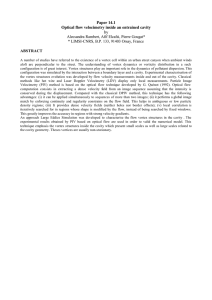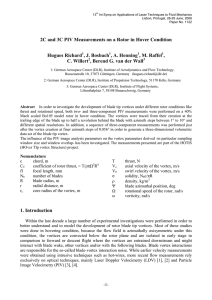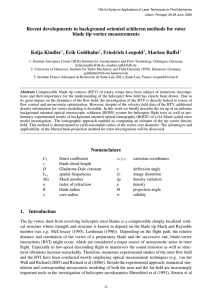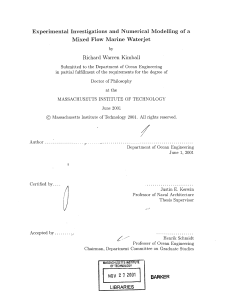PIV measurements of the vortical wake behind tilt-rotor blades C. Barla
advertisement
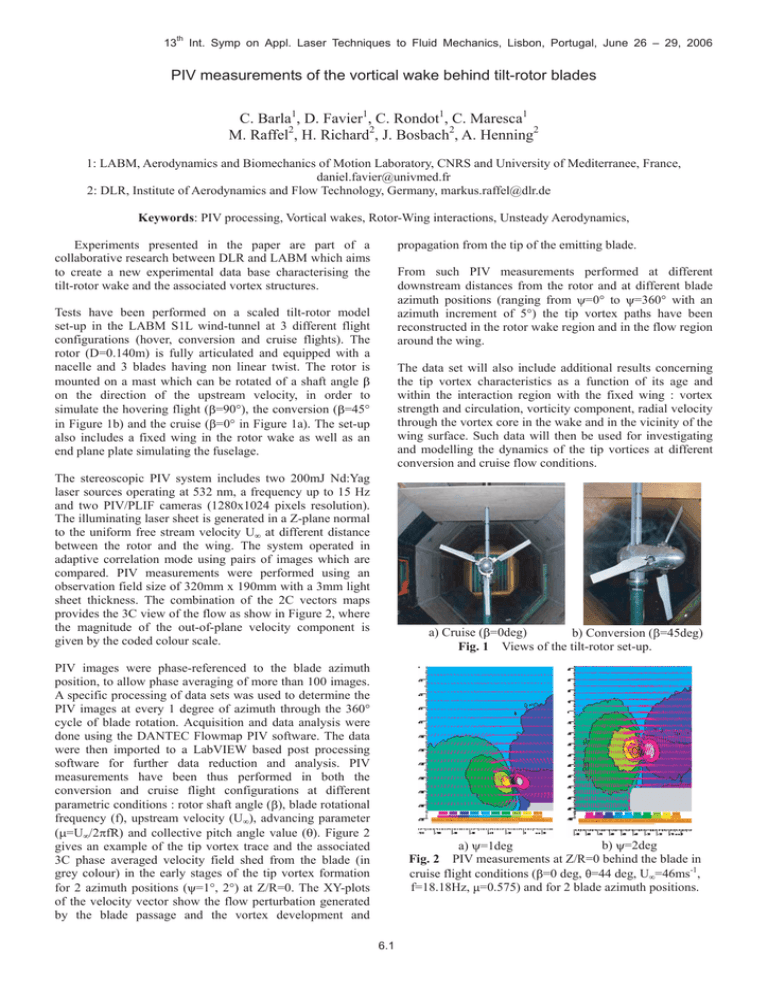
13th Int. Symp on Appl. Laser Techniques to Fluid Mechanics, Lisbon, Portugal, June 26 – 29, 2006 PIV measurements of the vortical wake behind tilt-rotor blades C. Barla1, D. Favier1, C. Rondot1, C. Maresca1 M. Raffel2, H. Richard2, J. Bosbach2, A. Henning2 1: LABM, Aerodynamics and Biomechanics of Motion Laboratory, CNRS and University of Mediterranee, France, daniel.favier@univmed.fr 2: DLR, Institute of Aerodynamics and Flow Technology, Germany, markus.raffel@dlr.de Keywords: PIV processing, Vortical wakes, Rotor-Wing interactions, Unsteady Aerodynamics, Experiments presented in the paper are part of a collaborative research between DLR and LABM which aims to create a new experimental data base characterising the tilt-rotor wake and the associated vortex structures. propagation from the tip of the emitting blade. From such PIV measurements performed at different downstream distances from the rotor and at different blade azimuth positions (ranging from =0° to =360° with an azimuth increment of 5°) the tip vortex paths have been reconstructed in the rotor wake region and in the flow region around the wing. Tests have been performed on a scaled tilt-rotor model set-up in the LABM S1L wind-tunnel at 3 different flight configurations (hover, conversion and cruise flights). The rotor (D=0.140m) is fully articulated and equipped with a nacelle and 3 blades having non linear twist. The rotor is mounted on a mast which can be rotated of a shaft angle on the direction of the upstream velocity, in order to simulate the hovering flight ( =90°), the conversion ( =45° in Figure 1b) and the cruise ( =0° in Figure 1a). The set-up also includes a fixed wing in the rotor wake as well as an end plane plate simulating the fuselage. The data set will also include additional results concerning the tip vortex characteristics as a function of its age and within the interaction region with the fixed wing : vortex strength and circulation, vorticity component, radial velocity through the vortex core in the wake and in the vicinity of the wing surface. Such data will then be used for investigating and modelling the dynamics of the tip vortices at different conversion and cruise flow conditions. The stereoscopic PIV system includes two 200mJ Nd:Yag laser sources operating at 532 nm, a frequency up to 15 Hz and two PIV/PLIF cameras (1280x1024 pixels resolution). The illuminating laser sheet is generated in a Z-plane normal to the uniform free stream velocity U at different distance between the rotor and the wing. The system operated in adaptive correlation mode using pairs of images which are compared. PIV measurements were performed using an observation field size of 320mm x 190mm with a 3mm light sheet thickness. The combination of the 2C vectors maps provides the 3C view of the flow as show in Figure 2, where the magnitude of the out-of-plane velocity component is given by the coded colour scale. a) Cruise ( =0deg) b) Conversion ( =45deg) Fig. 1 Views of the tilt-rotor set-up. PIV images were phase-referenced to the blade azimuth position, to allow phase averaging of more than 100 images. A specific processing of data sets was used to determine the PIV images at every 1 degree of azimuth through the 360° cycle of blade rotation. Acquisition and data analysis were done using the DANTEC Flowmap PIV software. The data were then imported to a LabVIEW based post processing software for further data reduction and analysis. PIV measurements have been thus performed in both the conversion and cruise flight configurations at different parametric conditions : rotor shaft angle ( ), blade rotational frequency (f), upstream velocity (U ), advancing parameter ( =U /2 fR) and collective pitch angle value ( ). Figure 2 gives an example of the tip vortex trace and the associated 3C phase averaged velocity field shed from the blade (in grey colour) in the early stages of the tip vortex formation for 2 azimuth positions ( =1°, 2°) at Z/R=0. The XY-plots of the velocity vector show the flow perturbation generated by the blade passage and the vortex development and b) =2deg a) =1deg Fig. 2 PIV measurements at Z/R=0 behind the blade in cruise flight conditions ( =0 deg, =44 deg, U =46ms-1, f=18.18Hz, =0.575) and for 2 blade azimuth positions. 6.1
